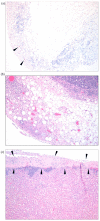Efficacy of Oral Remdesivir Compared to GS-441524 for Treatment of Cats with Naturally Occurring Effusive Feline Infectious Peritonitis: A Blinded, Non-Inferiority Study
- PMID: 37632022
- PMCID: PMC10458979
- DOI: 10.3390/v15081680
Efficacy of Oral Remdesivir Compared to GS-441524 for Treatment of Cats with Naturally Occurring Effusive Feline Infectious Peritonitis: A Blinded, Non-Inferiority Study
Abstract
Nucleoside analogs GS-441524 and remdesivir (GS-5734) are effective in treating cats with feline infectious peritonitis (FIP). However, no studies have compared the efficacy between antiviral medications. The objective of this study was to evaluate the efficacy of orally administered GS-442514 (12.5-15 mg/kg) compared to orally administered remdesivir (25-30 mg/kg) in a double-blinded non-inferiority trial. Eighteen cats with effusive FIP were prospectively enrolled and randomly assigned to receive either GS-442514 or remdesivir. Cats were treated daily for 12 weeks and evaluated at week 0, 12, and 16. Survival and disease remission at week 16 were compared between groups. Five of 9 (55%) cats treated GS-441524 and 7/9 (77%) cats treated with remdesivir survived, with no difference in survival rate (p = 0.2). Remdesivir fulfilled the criteria for non-inferiority with a difference in survival of 22% (90% CI; -13.5-57.5%). Three of the 18 cats died within 48 h of enrollment. Excluding these cats, 5/6 (83%) of the cats treated with GS-441524 and 7/9 (77%) of the cats treated with remdesivir survived. These findings suggest that both orally administered GS-441524 and remdesivir are safe and effective anti-viral medications for the treatment of effusive FIP. Further optimization of the first 48 h of treatment is needed.
Keywords: FIPV; antiviral; coronavirus; feline coronavirus; nucleoside analog; therapy.
Conflict of interest statement
The authors declare no conflict of interest.
Figures








Similar articles
-
Open label clinical trial of orally administered molnupiravir as a first-line treatment for naturally occurring effusive feline infectious peritonitis.J Vet Intern Med. 2024 Nov-Dec;38(6):3087-3094. doi: 10.1111/jvim.17187. Epub 2024 Sep 26. J Vet Intern Med. 2024. PMID: 39327677 Free PMC article.
-
Efficacy of oral remdesivir in treating feline infectious peritonitis: a prospective observational study of 29 cats.J Feline Med Surg. 2025 May;27(5):1098612X251335189. doi: 10.1177/1098612X251335189. Epub 2025 May 27. J Feline Med Surg. 2025. PMID: 40424099 Free PMC article.
-
Outcomes of treatment of cats with feline infectious peritonitis using parenterally administered remdesivir, with or without transition to orally administered GS-441524.J Vet Intern Med. 2023 Sep-Oct;37(5):1772-1783. doi: 10.1111/jvim.16803. Epub 2023 Jul 13. J Vet Intern Med. 2023. PMID: 37439383 Free PMC article.
-
Current status on treatment options for feline infectious peritonitis and SARS-CoV-2 positive cats.Vet Q. 2020 Dec;40(1):322-330. doi: 10.1080/01652176.2020.1845917. Vet Q. 2020. PMID: 33138721 Free PMC article. Review.
-
[Options for treatment of feline infectious peritonitis - previously and today].Tierarztl Prax Ausg K Kleintiere Heimtiere. 2023 Oct;51(5):351-360.. doi: 10.1055/a-2147-3999. Epub 2023 Nov 13. Tierarztl Prax Ausg K Kleintiere Heimtiere. 2023. PMID: 37956666 Review. German.
Cited by
-
Open label clinical trial of orally administered molnupiravir as a first-line treatment for naturally occurring effusive feline infectious peritonitis.J Vet Intern Med. 2024 Nov-Dec;38(6):3087-3094. doi: 10.1111/jvim.17187. Epub 2024 Sep 26. J Vet Intern Med. 2024. PMID: 39327677 Free PMC article.
-
Unlicensed antiviral products used for the at-home treatment of feline infectious peritonitis contain GS-441524 at significantly different amounts than advertised.J Am Vet Med Assoc. 2024 Feb 7;262(4):489-497. doi: 10.2460/javma.23.08.0466. Print 2024 Apr 1. J Am Vet Med Assoc. 2024. PMID: 38324994 Free PMC article.
-
Prospective Analysis of Clinicopathologic Correlates of At-Home Feline Infectious Peritonitis Treatment Using GS-441524.Pathogens. 2025 May 21;14(5):507. doi: 10.3390/pathogens14050507. Pathogens. 2025. PMID: 40430825 Free PMC article.
-
From Challenge to Cure: A Look at Feline Infectious Peritonitis and Emerging Treatment Strategies and Breakthroughs.Vet Sci. 2025 Jul 8;12(7):650. doi: 10.3390/vetsci12070650. Vet Sci. 2025. PMID: 40711310 Free PMC article. Review.
-
Serologic, Virologic and Pathologic Features of Cats with Naturally Occurring Feline Infectious Peritonitis Enrolled in Antiviral Clinical Trials.Viruses. 2024 Mar 17;16(3):462. doi: 10.3390/v16030462. Viruses. 2024. PMID: 38543827 Free PMC article.
References
-
- Murphy B., Perron M., Murakami E., Bauer K., Park Y., Eckstrand C., Liepnieks M., Pedersen N.C. The nucleoside analog GS-441524 strongly inhibits feline infectious peritonitis (FIP) virus in tissue culture and experimental cat infection studies. Vet. Microbiol. 2018;219:226–233. doi: 10.1016/j.vetmic.2018.04.026. - DOI - PMC - PubMed
Publication types
MeSH terms
Substances
LinkOut - more resources
Full Text Sources
Miscellaneous

